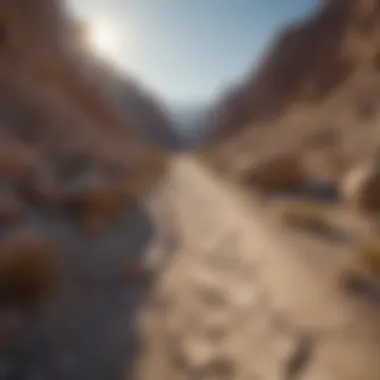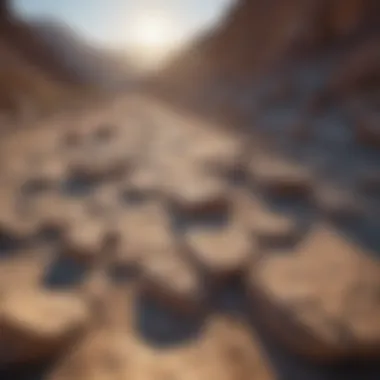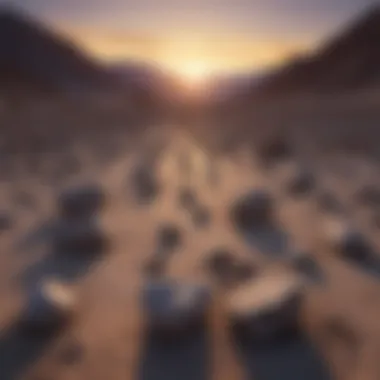Unlocking the Enigma: The Mystery of Moving Rocks in Death Valley Revealed


Rock and Fossil Identification
Geological Insights
To gain a comprehensive insight into the moving rocks in Death Valley, one must explore the geological formations and processes that have shaped this remarkable landscape. The historical significance of these rocks and fossils lies not only in their mysterious movement but also in the stories they tell about the Earth's geological past. Notable discoveries within Death Valley have provided valuable information about the region's geological history, shedding light on the forces that have sculpted its terrain over millennia. Understanding the geological insights offered by these moving rocks adds a layer of complexity to the enigmatic phenomenon, captivating researchers and rock enthusiasts alike.
Introduction
Death Valley holds within its vast expanse a mystery that has baffled both scientists and visitors - the phenomenon of moving rocks. This article aims to delve deep into the enigmatic nature of these rocks, exploring the intricacies that surround their peculiar movements. The importance of understanding this phenomenon lies in its ability to challenge our conventional notions of geology and physics, offering a glimpse into the unknown forces at play in the desolate landscapes of Death Valley.
Overview of Death Valley
Geographical features
Death Valley, with its dramatic topography and extreme environment, provides the backdrop for the mysterious behavior of the moving rocks. The unique geological formations of Death Valley contribute to the understanding of how these rocks move across the arid landscape. The rugged terrain, salt flats, and mountain ranges in Death Valley create a dynamic setting where these enigmatic movements occur. The harsh conditions and distinct geological features make Death Valley an ideal location for studying such anomalies, shedding light on the hidden mechanisms behind the rock's mysterious journey.
Climate conditions
The extreme climate conditions of Death Valley play a significant role in shaping the environment where the moving rocks reside. With scorching temperatures, minimal rainfall, and relentless sun exposure, Death Valley presents a challenging ecosystem for both life forms and geological phenomena. The arid conditions and sporadic weather patterns contribute to the preservation of the rock trails, allowing researchers to examine the tracks left behind by the moving rocks over time. The harsh climate, while inhospitable, provides a unique setting for studying the interactions between the rocks and their environment.
History of the Moving Rocks
Earliest observations
The earliest observations of the moving rocks date back to the early explorations of Death Valley, where travelers stumbled upon these inexplicable phenomena. These initial encounters sparked curiosity and intrigue, setting the stage for future investigations into the mysterious movements of the rocks. The documentation of these early observations serves as a historical record of the enigmatic nature of Death Valley's landscape, contributing to the ongoing quest to unravel the secrets of the moving rocks.


Scientific interest
The scientific community's interest in the moving rocks of Death Valley grew over the years as researchers sought to explain the mechanisms behind their peculiar motion. This fascination with the rocks' inexplicable journeys led to numerous studies and hypotheses aimed at deciphering the forces at work. The scientific interest in these anomalous movements highlights the ongoing quest for knowledge and discovery in the field of geology and earth sciences, opening doors to new inquiries and research directions.
The Mystery Unveiled
Research and Findings
Scientific Studies
Within the confines of scientific inquiry, the segment on Scientific Studies plays a pivotal role in guiding the discourse surrounding the moving rocks phenomenon. Through meticulous research efforts and data analysis, scientists have endeavored to uncover the underlying mechanisms driving the apparent motion of these geological entities. By leveraging various empirical methods and theoretical frameworks, researchers have made significant strides in demystifying the perplexing nature of the rock movements, offering valuable insights into the geophysical processes at play within Death Valley. The incorporation of rigorous scientific studies not only enriches our understanding of the phenomenon but also contributes to the broader field of geology, paving the way for new avenues of exploration and discovery.
Hypotheses Proposed
In the realm of theoretical conjecture, the segment focusing on Hypotheses Proposed presents a diverse array of possible explanations for the movement of rocks in Death Valley. From ice rafting hypotheses to wind and water erosion theories, researchers have put forth compelling conjectures aimed at elucidating the enigmatic behavior witnessed in this unique geological setting. By critically evaluating these hypotheses and analyzing their merits, readers are invited to engage with the complexities of scientific reasoning and the intricacies of hypothesis testing. The incorporation of diverse perspectives and theoretical frameworks not only stimulates intellectual discourse but also cultivates a sense of scientific curiosity, encouraging readers to explore the depths of natural phenomena with an inquisitive mindset.
Experimental Insights
Laboratory Simulations
Moving beyond theoretical deliberations, the segment on Laboratory Simulations offers a pragmatic approach to examining the phenomenon of moving rocks in Death Valley. Through controlled experiments and simulated scenarios, scientists are able to replicate the environmental conditions that may influence the movement of rocks across the desert terrain. By mimicking the interplay of wind, water, and geological formations in laboratory settings, researchers gain valuable insights into the potential forces underlying the observed rock motions, unraveling the intricate dynamics of this puzzling phenomenon. The integration of laboratory simulations not only enhances the credibility of scientific investigations but also underscores the importance of empirical validation in elucidating complex natural phenomena.
Field Observations
Complementing laboratory-based studies, the segment on Field Observations underscores the significance of on-site data collection and direct empirical observations in unraveling the mysteries of the moving rocks in Death Valley. By venturing into the field and closely examining the geological landscape where these enigmatic phenomena occur, researchers gain firsthand insights into the environmental factors and geological dynamics shaping the behavior of rocks in this desolate region. Through meticulous data collection and site-specific analyses, scientists are able to corroborate theoretical models with real-world observations, fostering a holistic understanding of the intricate processes governing the movement of rocks in Death Valley. The integration of field observations not only enriches the scientific discourse but also underscores the value of experiential knowledge in elucidating complex natural phenomena.


Theories and Speculations
Ice Rafting Hypothesis
Explanation of movement
The Ice Rafting Hypothesis stands out as a fascinating explanation for the movement of rocks in Death Valley. This hypothesis suggests that under specific conditions, ice sheets form around the rocks during cold winter nights. As the morning sun warms the valley, these thin sheets of ice begin to melt, creating a slippery surface that allows even large rocks to move effortlessly across the terrain. What makes this theory particularly intriguing is its ability to account for the smooth trails left behind by the rocks, resembling tracks left by ice rafts. The Ice Rafting Hypothesis's distinctive feature lies in its capability to provide a plausible mechanism that aligns with observed phenomena, making it a compelling choice for inclusion in this article.
Wind and Water Erosion Theories
Evidence supporting erosion
Concerning the Wind and Water Erosion Theories, evidence supporting erosion plays a significant role in elucidating the puzzling movements of rocks in Death Valley. The presence of wind and water channels combined with the gradual wearing down of rock surfaces point towards erosion as a contributing factor to the displacement of these rocks. The key characteristic of this theory lies in its ability to explain how external forces, such as wind patterns and intermittent water flows, can gradually influence the movement of rocks over time. By highlighting the erosional impact on the landscape, this theory offers valuable insights into the dynamic processes shaping Death Valley's terrain. Its consideration within this article adds a layer of geological understanding that complements other hypotheses, enriching the discourse on this intriguing phenomenon.
Affect on rock movement
Further delving into the Wind and Water Erosion Theories, exploring the affect on rock movement unveils a compelling facet of the phenomenon. The constant shaping and sculpting effects of wind and water on the rocks illustrate how these natural elements play a pivotal role in determining the trajectory and speed of rock displacement. The key characteristic of this aspect lies in its ability to showcase the intricate interplay between environmental factors and rock mobility. By outlining how erosion processes directly influence the movement patterns of rocks in Death Valley, this theory provides a nuanced perspective on the complex interconnections between geology and natural forces. Its addition to this article amplifies the depth of analysis and underscores the multifaceted nature of the moving rock mystery.
Impact and Significance
The section of Impact and Significance within the context of moving rocks in Death Valley goes beyond mere geological curiosity. It serves as a pivotal point in understanding the broader implications and scientific relevance of this perplexing phenomenon. By delving into the movement of rocks in one of the harshest environments on Earth, researchers unravel hidden truths about natural processes and interactions that can potentially extend beyond just rock movements. By analyzing the significance of the topic, we gain insights into the fragility and resilience of geological formations under extreme conditions, shedding light on potential resilience strategies that could be applied elsewhere. Exploring the broader impact and significance of these moving rocks prompts us to reconsider our understanding of geomorphological processes and their potential implications for Earth's geological evolution.
Scientific Curiosity
Contributions to geology


Diving deep into the contributions of moving rocks in Death Valley to the field of geology reveals a myriad of fascinating insights. This aspect not only adds to our understanding of sedimentology and erosion mechanisms but also offers a unique perspective on how geological formations can undergo subtle yet significant changes over time. The study of these moving rocks provides valuable data for researchers studying dynamic geological processes, offering a platform for further research and experimentation. Additionally, unraveling the mysteries of these rocks opens up avenues for exploring the underlying geological history of the region and expanding our knowledge of rock behavior in extreme environments.
Implications for other phenomena
The implications of studying moving rocks in Death Valley stretch beyond the realm of geology, impacting our understanding of various natural phenomena. By examining how environmental factors and geological conditions influence the movement of rocks, researchers can draw parallels to other geological mysteries and phenomena worldwide. This broader perspective not only enhances our comprehension of Earth's dynamic processes but also fuels scientific curiosity and innovation in related fields. Understanding the implications of rock movements in Death Valley can potentially lead to breakthroughs in studying similar phenomena in different landscapes, enriching our knowledge of geological complexities and their interconnectedness.
Tourism and Public Interest
Attraction for visitors
The allure of the moving rocks in Death Valley transcends scientific curiosity, captivating visitors from around the globe. The phenomenon serves as a unique natural spectacle that draws enthusiasts, researchers, and casual tourists alike to witness the intriguing dance of rocks across the desert floor. The enchanting mystery behind these moving rocks adds a sense of wonder and adventure to the visitor experience, making Death Valley a must-visit destination for those intrigued by the wonders of nature. By exploring the attraction these rocks hold for visitors, we unravel a tapestry of landscapes and narratives that continue to fascinate and inspire explorers of all kinds.
Local folklore
In addition to its scientific relevance, the phenomenon of moving rocks in Death Valley holds deep cultural significance embedded in local folklore. Stories and legends surrounding these enigmatic rocks have been passed down through generations, enriching the cultural tapestry of the region and adding layers of mystery to their movements. The integration of local folklore into the narrative of these moving rocks offers a glimpse into the symbiotic relationship between nature and human imagination, shaping perceptions and interactions with the landscape. By exploring the interplay between folklore and geological phenomena, we bridge the gap between scientific inquiry and cultural storytelling, creating a truly immersive and multi-dimensional experience for visitors and researchers alike.
Conclusion
Unsolved Enigma
Continued fascination
Exploring the facet of continued fascination within the context of the moving rocks in Death Valley unveils a persistent intrigue that captivates both scientists and enthusiasts. The enduring appeal of these rocks lies in their elusive nature, defying conventional explanations and inviting further scrutiny. The key characteristic of this continued fascination is its ability to spark ongoing discussions and examination, fueling intellectual curiosity and inspiring new avenues of exploration within the field.
Furthermore, the unique feature of continued fascination centers on its timeless allure, positioning the moving rocks as a topic of perpetual interest that transcends generations. While the subject may have been scrutinized extensively, its enigmatic essence remains a magnet for those seeking to unravel the secrets of Death Valley's geological marvels.
Future research directions
Looking towards future research directions presents a compelling trajectory for advancing our understanding of the moving rocks in Death Valley. By charting out potential avenues for inquiry, we can harness fresh perspectives and methodologies to illuminate this baffling phenomenon. The key characteristic of these research directions is their capacity to foster innovation and scientific progress, paving the way for groundbreaking discoveries in the realm of geology and earth sciences.
Moreover, the unique feature of future research directions lies in their potential to propel the study of moving rocks towards new frontiers, transcending existing limitations and expanding the boundaries of knowledge. By embracing these directions, researchers can uncover hidden dimensions of the phenomenon, unlocking insights that may reshape current paradigms and redefine our perceptions of natural processes in extreme environments like Death Valley.







